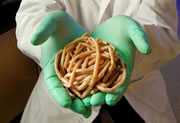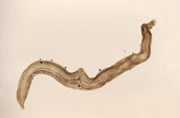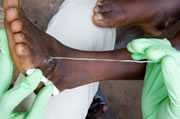CDC's WASH Away Neglected Tropical Diseases (NTDs) Activity
Program Description
In 2010, more than 780 million people around the world did not use improved sources of drinking water * 1. Millions more got their drinking water from improved but unsafe contaminated sources. Additionally, 2.5 billion people did not use improved sanitation ** 1. At any time, close to half the people living in the developing world are suffering from one or more diseases resulting from inadequate water, sanitation, and hygiene (WASH) 2.
The most well-known WASH-related disease is diarrheal illness. Two and a half billion cases of diarrhea occur in children younger than 5 years of age every year, and about 801,000 children die from it annually 3. Millions more people suffer from WASH-related neglected tropical diseases (NTDs), such as soil-transmitted helminthiases (STHs, for example, infections with Ascaris, hookworm, and Trichuris), Guinea worm disease (GWD), trachoma, and schistosomiasis.

Ascaris lumbricoides worms
passed by a child in Kenya.
Facts about WASH-related NTDs
- More than 1 billion people are infected with STHs. Infections can lead to learning disabilities, massive diarrhea, or anemia 4. STHs are associated with at least 12,000 deaths each year 5. Improved WASH can result in a 29% decrease in illness from Ascaris, one of the STH worms 6.
- GWD is one of the few infectious diseases spread only by contaminated water. It is likely to be the second disease eradicated from the world after smallpox. It causes long-term disability that can even impact a society's agricultural and animal care activities. Before recent improvements made by the Guinea Worm Eradication Program, GWD caused millions of dollars in economic losses per year and decreased school attendance by 60% in some villages with widespread infection 7, 8, 9. Improved water supplies can result in a 78% reduction in
GWD 6. - Trachoma is the leading cause of preventable blindness. Almost 8 million people worldwide have been blinded by trachoma, and an estimated 84 million people are in need of trachoma treatment 10. The spread of trachoma is strongly related to overcrowding, lack of water for washing faces and hands, and inadequate disposal of human and animal waste 11. Improving WASH can reduce trachoma by 27% 6.
- About 200 million people are infected with schistosomiasis 12, which causes tens of thousands of deaths every year, mostly in Sub-Saharan Africa 5. Schistosomiasis results from the unhealthy disposal of human waste and the lack of nearby sources of safe water. Basic sanitation can reduce this disease by as much as 77% 6.

Microscopic Schistosoma mansoni
Improved, sustainable WASH is essential to prevent disease in the world’s poorest countries. This involves:
- Increasing access to healthy and safe water
- Managing human waste
- Improving hygiene and environmental management
These improvements can lead to better health, poverty reduction, and socio-economic development. There are many programs to prevent and control NTDs that focus on supplying medications to an entire group or population, known as mass drug administration (MDA). Greater emphasis on disease prevention through improved WASH would increase the chances of sustaining these MDA programs for years to come.
What is CDC's WASH Away NTDs Program Doing?

Extracting guinea worm from leg
CDC's WASH Away NTDs Activity, along with partner organizations and ministries of health, are evaluating the:
- Effectiveness of WASH interventions in reducing disease
- Factors that help and prevent WASH delivery
- Integration of WASH with disease prevention programs
- Sustainability of WASH interventions
Findings from these evaluations will be used to develop recommendations to successfully integrate WASH into existing NTD and other disease control programs for long-term success.
Top of Page* Improved sources of drinking water refer to 1. piped household water connections located inside the users’ dwellings, plots or yards; 2. public taps or standpipes; 3. tube wells or boreholes; 4. protected dug wells; 5. protected springs; and 6. rainwater collection 2. These improvements do not necessarily mean the water is microbiologically safe.
** Improved sanitation refers to facilities that ensure hygienic separation of human excreta from human contact. They include 1. flush or pour-flush toilets/latrines emptying into piped sewer systems, septic tanks, or pit latrines; 2. ventilated improved pit (VIP) latrines; 3. pit latrines with slabs; and 4. composting toilets 2.
References
- World Health Organization and UNICEF. Progress on Drinking Water and Sanitation: 2012 Update. United States: WHO/UNICEF Joint Monitoring Programme for Water Supply and Sanitation; 2012.
- UNDP. Human Development Report 2006. Beyond scarcity: power, poverty and the global water crisis.
- Liu L, Johnson HL, Cousens S, Perin J, Scott S, Lawn JE, Rudan I, Campbell H, Cibulskis R, Li M, Mathers C, Black RE; Child Health Epidemiology Reference Group of WHO and UNICEF. Global, regional, and national causes of child mortality: an updated systematic analysis for 2010 with time trends since 2000. Lancet. 2012 Jun 9;379(9832):2151-61.
- World Health Organization. Soil-transmitted helminthes.
- World Health Organization. The World Health Report 2002.
- Esry SA, et al. 1991. Effects of Improved Water Supply and Sanitation on Ascaris, Diarrhea, Dracunculiasis, Hookworm Infection, Schistosomiasis, and Trachoma. Bulletin of the World Health Organization 69 (5):609-21.
- Hopkins DR, Ruiz-Tiben E, Ruebush TK, et al. Dracunculiasis Eradication: Delayed, Not Denied. American Journal of Tropical Medicine and Hygiene. 2000;62(2):163-8.
- Hopkins DR, Hopkins EM. Guinea Worm: The End in Sight. In: Medical and Health Annual, E. Bernstein ed. Encyclopedia Britannica Inc., 1991 Chicago.
- Ruiz-Tiben E, Hopkins DR. Dracunculiasis (Guinea worm disease) eradication. Advances in Parasitology. 2006;61:275-309.
- World Health Organization. Trachoma.
- World Health Organization. Water-related Diseases: Trachoma.
- World Health Organization. Schistosomiasis.
- Page last reviewed: September 4, 2012
- Page last updated: September 4, 2012
- Content source:


 ShareCompartir
ShareCompartir